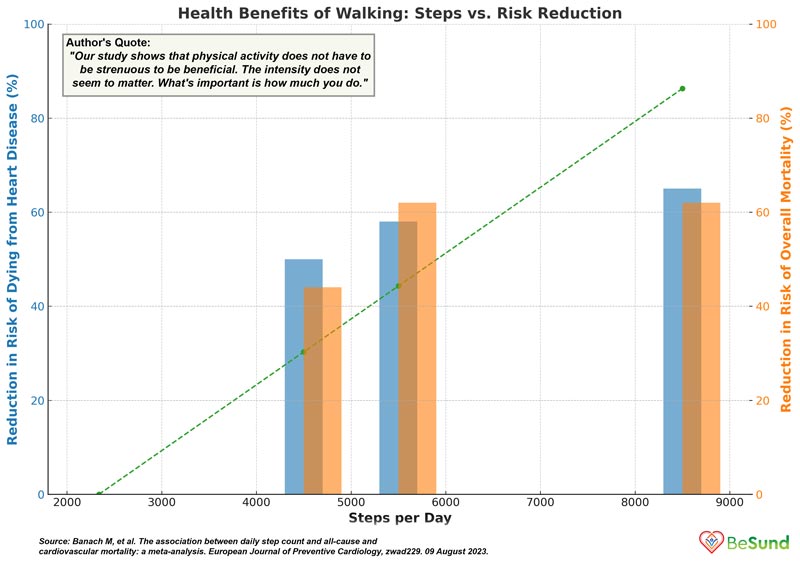5,000 Steps a Day Health Benefits isn’t just a catchy phrase; it’s a transformative approach to daily wellness. Walking, an activity so intrinsic to human nature, has often been overlooked in the domain of health. Yet, as we progress, it’s clear that every step counts, and perhaps, we’ve been aiming too high with the famed 10,000 steps.
A recent study has brought the 5,000 steps into focus, challenging long-standing beliefs. But is this just another health fad, or is there substantial evidence behind it? This question drives us to explore deeper, seeking answers grounded in science.
In this blog post, we’ll explore the numerous facts on the health implications of these 5,000 steps. We aim to provide a comprehensive understanding, sifting through research and expert opinions, to present a clear picture of its benefits.
The purpose of the post is to empower you with knowledge, enabling informed decisions about your daily routines. So, lace up your walking shoes and join us as we stride into the world of “5,000 Steps a Day Health Benefits.”
Why Steps are Important
Walking is more than just a mode of transportation; it’s a cornerstone of fitness activity. The concept of 5,000 Steps a Day Health Benefits has been gaining traction, emphasising that even moderate walking can offer significant health advantages.
The widely promoted benchmark of 10,000 steps daily is a common fitness goal. However, the evidence for this specific target needs to be more extensive. Studies have shown that even a plan less than this, such as 5,000 steps, can offer health benefits. Regardless of the exact number, higher step counts have consistently been linked with lower mortality rates, especially in older adults.
Step cadence, or the intensity of steps, is another focal point in the health and wellness community. Some studies indicate that a brisker walking pace, or higher step cadence, correlates with improved cardiometabolic health, particularly in women. Yet, the relationship between step intensity and overall health is still under investigation.
The transition from high school to college often sees a decline in physical activity, making college students particularly susceptible to weight gain. Walking, and tracking it through steps, can play a pivotal role in managing this weight. Pedometers, which count steps, have proven effective in promoting physical activity. Their use has led to notable increases in daily step counts, emphasising their potential in fighting against sedentary lifestyles and associated weight gain.

5,000 Steps a Day Health Benefits: What Recent Research Reveals
A groundbreaking study has emerged, diving deeper into daily step counts, offering fresh insights into the 5,000 Steps a Day Health Benefits. While many of us have been conditioned to aim for the 10,000-step mark, this research suggests that half that number can still yield significant health advantages.
Banach and his team conducted an extensive investigation, analysing the daily step habits of over 50,000 participants. Their findings were nothing short of revelatory. Individuals who consistently hit the 5,000-step mark experienced a remarkable 50% reduction in all-cause mortality risk. This means that even without reaching the often-touted 10,000 steps, one can still harness substantial health benefits.
Furthermore, the cardiovascular benefits of this step count were even more pronounced. Those who walked 5,000 steps daily saw a 65% decrease in their risk of cardiovascular-related deaths. This is especially significant given the rising global rates of heart diseases and related conditions.
Interestingly, the study also highlighted that the intensity of these brisk or leisurely steps didn’t significantly alter the health outcomes. This is a boon for those who prefer a gentler pace or might have mobility constraints.
While the 10,000-step goal isn’t without its merits, it’s clear that even half that number can be a game-changer for many. With the modern sedentary lifestyle posing numerous health challenges, integrating a manageable step count like 5,000 into our daily routines can be a proactive step towards better health.

Using the study’s findings, the graph above has been produced to visually represent the relationship between daily step counts and health benefits.
The blue bars depict the decrease in risk of dying from heart disease as daily steps increase. Starting from just under 2,500 steps, there’s a noticeable benefit, and this advantage grows substantially as one approaches the 5,000 and 8,500 step marks.
The orange bars, on the other hand, highlight the overall mortality risk reduction associated with different step counts. Even a modest count of around 4,000 steps daily offers significant benefits.
Lastly, the green dotted line showcases the incremental benefits of every extra step taken. Essentially, every additional stride contributes to improved heart health.
This visual representation underscores the study’s conclusion: every step, whether few or many, counts towards better health.
How Did the 10,000 Steps Concept Begin: Marketing vs. Medical Advice?
The allure of the “10,000 steps a day” mantra has captivated fitness enthusiasts worldwide. But where did this seemingly arbitrary number originate, and is it grounded in scientific evidence or merely a marketing gimmick? Let’s examine the history and investigate the mystery behind this popular fitness benchmark.
In the 1960s, as Japan was gearing up for the 1964 Tokyo Olympics, there was a heightened emphasis on physical fitness among its citizens. The nation was becoming increasingly aware of the importance of regular exercise in combating lifestyle diseases such as hypertension, diabetes, and obesity. Walking, an accessible and universal form of exercise, emerged as the preferred choice for many. It required no special equipment, training, or coaching, making it an ideal activity for the masses.
Enter the pedometer, a device that would revolutionise how people perceive walking. In 1965, a Japanese company named Yamasa Clock introduced the Manpo-kei pedometer, which translates to “10,000 steps meter.” The name wasn’t derived from scientific research but a clever marketing strategy.
The Japanese character for 10,000 resembles a person in motion, further reinforcing the idea of movement and walking. This catchy name and its easy-to-remember goal ensured the device’s rapid popularity.

The Manpo-kei wasn’t just a product; it became a movement. Soon after its launch, walking clubs sprouted across Japan, with members dedicated to achieving the 10,000-step daily target. The concept quickly transcended Japanese borders, influencing health-conscious individuals globally.
Today, many fitness experts and wellness apps advocate for the 10,000-step goal, often presenting it as the gold standard for optimal health. However, the question remains: Is there any scientific basis for this number?
Dr Lee’s research on older women revealed that even a modest 4,400 steps daily could significantly lower mortality risk, with benefits plateauing around 7,500 steps. This suggests that 10,000 steps might be an admirable goal, but it’s not necessarily the magic number for everyone. Moreover, for highly active individuals, sometimes fitting in 10,000 steps daily can be challenging, emphasising the need for a more personalised approach to fitness.
While the 5,000 Steps a Day Health Benefits are now being recognised, the 10,000 steps concept, rooted more in marketing than medicine, serves as a reminder that health guidelines should be tailored to individual needs and not just universally accepted numbers.
5,000 Steps a Day Health Benefits: Physical and Mental
The age-old adage, “Every journey begins with a single step,” rings true, especially when discussing the health benefits of walking. While the 10,000 steps a day benchmark has been the gold standard for many, recent findings suggest that even half of that can offer substantial health benefits. Let’s explore the physical and mental advantages of embracing the 5,000 steps a day lifestyle.
Physical Benefits
- Cardiovascular Health: One of the most significant benefits of walking is its positive impact on heart health. Walking less than 5,000 steps a day was traditionally deemed sedentary, potentially detrimental to cardiovascular health. However, recent studies indicate that even a modest step count of just under 2,500 steps can help reduce the risk of dying from heart disease.
- Overall Mortality: The correlation between step count and overall mortality is compelling. Walking just under 4,000 steps a day has been associated with a reduced risk of dying from all causes. This suggests that walking is beneficial even if one still needs to reach the 5,000 or 10,000 step mark.
- Incremental Benefits: Every step counts, quite literally. For every additional 500 steps taken, there’s a 7% reduction in the risk of dying from heart disease. Doubling that to an extra 1,000 steps correlates with a 15% reduction in the risk of dying from all causes. This incremental benefit underscores the idea that more is better regarding walking.
Mental Benefits
- Stress Reduction: Walking can be a moving meditation, especially in natural settings. The rhythmic pattern of steps can help calm the mind, reduce anxiety, and elevate mood.
- Cognitive Function: Regular physical activity, including walking, has been linked to improved cognitive function and a reduced risk of cognitive decline as we age.
- Emotional Well-being: Achieving daily step goals, whether 2,500, 5,000, or 10,000, can provide a sense of accomplishment. This can boost self-esteem and overall emotional well-being.
The 5,000 Steps a Day Health Benefits extend beyond just physical wellness. They encompass a holistic approach to health, benefiting the body and the mind. Whether you’re a seasoned walker or just starting, remember that every step is a stride towards better health.
Incorporating Walking into Your Routine
Walking is an exercise that’s accessible to most people. It’s free, requires no special equipment, and can be done anywhere. But how can you seamlessly integrate walking into your daily routine to reap its benefits? Explore strategies and fun facts that inspire you to lace up those walking shoes more often.
Strategies to Incorporate Walking
- Set Clear Goals: Start with a manageable goal, like 2,500 steps a day, and gradually increase it. Remember, even walking less than 5,000 steps has its benefits.
- Use Technology: Wearable devices can track your steps and motivate you. People who track their steps tend to walk an average of 2,500 more daily.
- Walk the Talk: Suggest a walk instead of sitting down for a coffee or meeting. It’s a great way to get business done and your steps in.
- Take the Stairs: Opt for stairs over elevators. Climbing stairs burns calories two to three times faster than walking without an incline.
- Park Further Away: Parking further at work or the shopping store can add extra steps to your day.
- Engage in Fun Activities: Join walking clubs or participate in charity walks. Walking in groups can be motivating and social.
Fun Facts about Walking
- Before baseball became popular, competitive walking was America’s favourite spectator sport in the 1870s and 1880s.
- The first Wednesday in April is celebrated as National Walking Day.
- Walking can boost creativity by up to 60 per cent.
- Australians walk the most, averaging 9,695 steps daily, while Americans average about 5,117.
- Walking is the most popular form of exercise in the U.S.
- Thomas Jefferson, who lived to be 83 when the average life expectancy was 40, walked four miles daily.
- The longest uninterrupted walk was 19,019 miles from the southern tip of South America to Alaska, taking 2,425 days.
- Listening to music while walking can improve mood, motivation, and performance.
- Since the days of Socrates, walking has been linked to enhanced cognitive functioning and creativity.
For more fun facts, check out ‘Fun Facts About Walking’.

Walking Towards a Healthier Future
As we conclude our exploration of the world of walking and its myriad benefits. Every step we take is a testament to our commitment to health and well-being. From the historical allure of the 10,000 steps to the transformative potential of the 5,000 Steps a Day Health Benefits, walking stands as a simple yet powerful tool in our wellness arsenal.
This post has illuminated the multifaceted benefits of walking, both physical and mental. We’ve laid bare myths, highlighted groundbreaking research, and provided actionable strategies to seamlessly integrate walking into our daily routines. The evidence is clear: walking offers profound health advantages regardless of the exact step count.
But beyond the numbers and the science, walking represents a broader philosophy. It’s about taking charge of our health, one step at a time. Recognising that even small, consistent efforts can bring significant positive changes. It’s about understanding that our health is an ongoing journey, and every step we take is a stride towards a brighter, healthier future.
In our fast-paced world, where technology often dominates our lives, walking is a gentle reminder of the simple joys of life. The intangible rewards of walking are the rhythmic cadence of our steps, the fresh air, the connection with nature, and the sense of accomplishment as we hit our daily goals.
At BeSund, we believe in empowering our readers with knowledge and insights that can make a tangible difference in their lives. As we wrap up this post, we hope you feel inspired to embrace the 5,000 Steps a Day Health Benefits in all its glory. Whether aiming for 2,500, 5,000, or 10,000 steps, remember that the journey is as important as the destination.
So, lace up those shoes, set your goals, and walk towards a healthier, brighter future. After all, every step counts.
Thank you for joining us on this enlightening journey. Stay active, stay informed, and most importantly, stay healthy and BeSund!
Sources
- Banach M, et al. The association between daily step count and all-cause and cardiovascular mortality: a meta-analysis. European Journal of Preventive Cardiology, zwad229. 09 August 2023.
- Bravata D.M., et al. Using pedometers to increase physical activity and improve health: a systematic review. JAMA, 2007.
- Jefferis BJ, et al. Objectively measured physical activity, sedentary behaviour and all-cause mortality in older men. Br J Sports Med. 2019;53(16):1013-1020.
- Lobelo F, et al. Routine assessment and promotion of physical activity in healthcare settings: a scientific statement from the American Heart Association. Circulation. 2018;137(18):e495-e522.
- Rooney BL, et al. Growing healthy families: families use pedometers to increase physical activity and slow the rate of obesity. WMJ, 2005.
- Tudor-Locke C, et al. Step-based physical activity metrics and cardiometabolic risk: NHANES 2005-2006. Med Sci Sports Exerc. 2017;49(2):283-291.
- Wengreen and Moncur. Change in diet, physical activity, and body weight among young adults during the transition from high school to college. Nutrition Journal, 2009.



